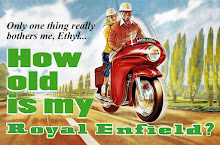 |
| What's this 250cc motorcycle from China doing at a polo meet? |
The valets at the polo grounds in Wellington, Fla. were going to have to deal with two Bentley convertibles — both white — observed my friend,
author Douglas Kalajian, as he waited to park his Acura at a recent match.
Would they park the Bentleys side by side?
Bentleys by the bucket load were no surprise at polo in Palm Beach County. What I did not expect to see, tucked away near the clubhouse, was a 250cc Chinese motorcycle built to resemble an American hard tail chopper.
Among the Google ads you'll see on this blog from time to time is an ad for
just such a motorcycle from
Scooter Depot, a California importer.
Their bare bones chopper, with apehanger handlebars and a just-introduced springer front end, was offered on the Internet recently for $2,559, plus $69 for a six-month warranty, plus $299 for shipping. Roughly $3,000.
It might be fun, but the stark, over-long frame and exaggerated handlebars are unattractive. I can't get over how long the drive chain looks! There is no vintage reference to the motorcycles of yore, either: Scooter Depot is careful to hide any sign of a brand name in its catalog pictures. You've doubtless never heard of the Chinese builder anyway.
The Scooter Depot ad indicates that I can specify my first choice and second choice for a color (black and matte black are the only two offered) but presumably I will have to take what comes in the box.
Despite the obvious resemblance, the motorcycle I saw at polo was not one of those; not exactly. The motorcycle I saw was labelled "thaHeist 250," by Cleveland Cycle Werks. The spelling of "tha" and "Werks" tell you this is a motorcycle from the age of rap, not rock.
 |
| The motorcycle I spotted was thaHeist 250 from Cleveland Cycle Werks. |
Despite a likely common origin, Cleveland Cycle Werks claims bespoke touches to its motorcycle that the Scooter Depot machine may lack. According to its website:
"We do not completely assemble our bikes in the USA. We leverage Chinese cost advantage to complete our bikes and keep them extremely affordable. We do however support over 50 families in the USA with jobs. Our products are the result of passion put forth by many people in Cleveland. The motorcycle business is not easy and we would not be doing this if we were not passionate about it. Many late nights and 20 hour workdays were spent to complete the Heist. Designed, prototyped and engineered in Cleveland Ohio."
Elsewhere on the site, Cycle Werks founder Scott Colosimo dismisses concerns that his 250cc motorcycle might be unsatisfying.
"I get guys telling me all the time that they are too much a man to ride a 250cc bike. Really? They tell me that I have no idea what it is like to ride a 1000cc bike. Well, before CCW, I was pursuing a lovely track day and race addiction piloting my Ducati 749s Monoposto past many GSXR 1000 and 750s. For the street, I go straight for the smaller bikes every time. A liter bike gets me into too much trouble on the street."
 |
| ThaHeist I spotted looked left out in the weather. |
The Heist I spotted was obviously not new and perhaps not well cared for, as spots of corrosion peeked through on the bright work. Photos on the
Cleveland Cycle Werks website show the no doubt improved 2013 model. MSRP is given as $3,295.


































































